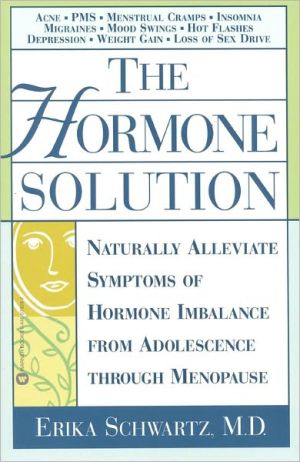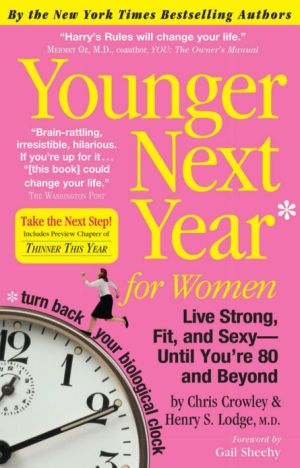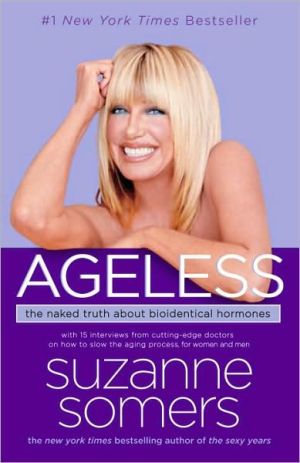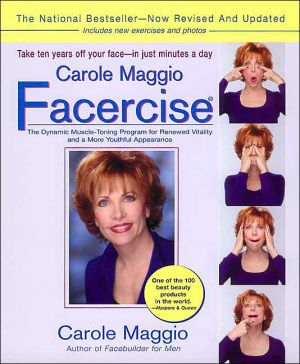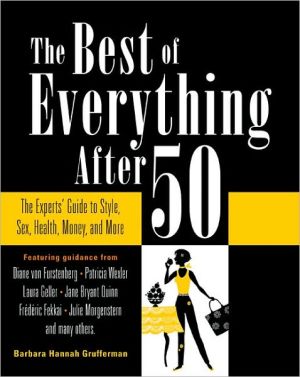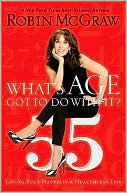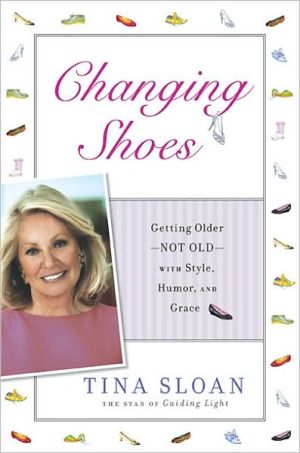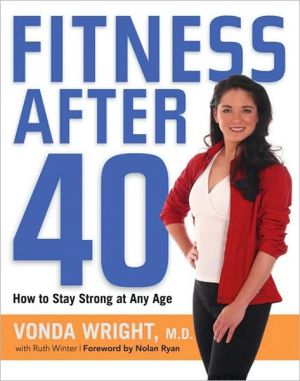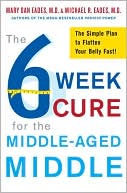The Hormone Solution: Naturally Alleviate Symptoms of Hormone Imbalance from Adolescence Through Menopause
In this work, Dr Erika Schwartz shares her proven programme to help women prevent, reduce and even eliminate the symptoms of hormone imbalance naturally.
Search in google:
Hormones are the regulators of our bodies -- when they are in balance we feel good, look great, and are able to approach life on our own terms. When they are out of balance or changing because of adolescence, pregnancy, or menopause, they can lead to both common problems and devastating conditions such as infertility, postpartum depression, fibroid cysts, insomnia, and memory loss. Dr. Erika Schwartz never questioned the conventional methods of treating menopausal women until she went through "the change" and realized how ineffective they were for her. Intrigued by the natural hormones derived from soy and yams, she started prescribing these natural forms of estrogen and progesterone for herself and her patients. The results were astounding. Now Dr. Schwartz shares her successful, proven program to help women of all ages prevent, reduce, or even eliminate the symptoms of hormone imbalance naturally. Natural Health ...a clear accessible account of the role of hormones in health...
Chapter 1\ Menopause is not a pause. While menopause literally means "cessation of menstrual periods," for most women it defines the most traumatic part of their lives. It forces them to confront the inevitability of aging. It is not a glorious transition; it is not a time when women feel free and empowered.\ As one of my patients put it, "The menopausal experience changes one's sense of self. Lots of little things go wrong and then suddenly, one day, you find you are not the same person anymore." It is the accumulation of many symptoms and changes that become progressively less manageable and end up all too often with disastrous consequences. These disastrous consequences affect more than forty-three million women today, along with twenty-one million women who will be reaching their menopausal years in the next decade. The research on menopause is limited, solutions scarce, information contradictory. In 1993, the National Institutes of Health started a ten-year study to compare hormone replacement therapy with diet, exercise, and calcium supplementation in the prevention of cancer, heart disease, and osteoporosis. The results of this study will not be available until 2005 at the earliest. Who has time to wait until then? Definitely not the millions of women suffering from symptoms of hormone imbalance today. Those women have options; all they need is an understanding that menopause is simply another change -- it does not happen overnight -- it's another transition in the continuum of change in our lives.\ Indeed, long before we reach the point of being overwhelmed by the symptoms of menopause, long before we feel totally betrayed by our bodies, little by little, onesymptom at a time, menopause unfolds over more than thirty years. The key to preventing the serious and devastating problems created by menopause is found in understanding the correlation between these symptoms we experience at all times during our lives and the hormone imbalance that causes them. The symptoms begin when we are in our teens, and they follow us throughout our lives with incredible tenacity. Let's look back in time and see when they begin and what causes them to occur. Once we realize that these symptoms are part of our lives at all ages, we can uncover their root cause. If we connect our symptoms to the particular type of hormone imbalance that causes them -- regardless of age -- then we can treat the problem and prevent it from recurring or getting worse. In The Hormone Solution, I'll provide you with a comprehensive solution for the treatment of the normal changes that affect women (and men) throughout their lives.\ Does the following sound familiar? You're thirteen. You are an accomplished athlete and a tomboy. You refuse to wear dresses even when you go to church. Your mother is concerned because all your friends have gotten their periods while you show no signs -- no breast buds, no perspiration odor, no pubic hair. Your mother takes you to the doctor, and your blood tests, physical examination, and CT brain scan are normal. Nothing changes for another three years. And then, over a period of six months, you become a girl -- you stop being a tomboy, you grow breasts, get your period, and start blushing when you meet a boy.\ Or maybe this rings a bell? You're twenty-four. You just had your second child. The pregnancy was uneventful, and your baby is beautiful and healthy. Although you have plenty of support from your family and friends, you're getting depressed. With each passing day, your family helplessly watches you lose interest in the baby and yourself. You finally give in to your husband's pleas to go see a doctor. You're diagnosed with postpartum depression.\ Perhaps you're at a later stage: You remember when you were thirty-two and would come home from work and finally finish with the husband, the kids, and the phone calls. Those were the days when you were done with another long but rewarding day and couldn't wait to hit the sack. You'd crawl into bed and fall asleep within a minute. You slept as if you were in a coma. Now, fifteen years later, you're forty-seven. Your job is secure, your kids have their driver's licenses and are ready to go to college, your husband and you have stopped bickering over the position of the toilet seat cover, and just when you thought things should be getting easier, something very strange has happened.\ By 10 p.m., you are so exhausted you barely make it through brushing your teeth and applying your five different antiwrinkle creams guaranteed to take ten years off your face. You're extremely tired but you dread getting into bed because you know what follows will be a torture you never believed possible. And yet, you have no choice, you know you need the rest. So you go to bed, and thankfully, you fall asleep: but not for long. Suddenly, it feels as though a bolt of lightning has shot through you. You jump up, it's 2 a.m., you're lying in a pool of sweat, and your body temperature feels high enough to boil water. The sheets are twisted around you; your heart is pounding hard. You're fairly sure you aren't having a heart attack because the same thing has happened every night for months now. Suddenly, you realize you have to pee so badly that you're not sure you can make it to the bathroom. Holding on to the walls, you reach the toilet and pray this activity won't wake you up too much. You return to bed and pull the blanket to your nose as a cold shiver runs through your body. You close your eyes and try not to think of the perspiration-soaked sheets, which have now turned to ice. You look around and wonder why the man lying next to you is sleeping soundly. You lie awake for hours desperately wanting and needing to sleep. When the alarm goes off in the morning, you want to die. You cannot believe it's time to start another day feeling this way.\ What happened? What has changed between the time you were thirteen and forty-seven?\ The answer is simple: Your hormones. Let's assume that our lives are a jigsaw puzzle. The pieces that make up the puzzle are our hormones. Having all the pieces isn't enough. What we must know is how the pieces fit and, once they do, how to keep the puzzle together. When you're thirteen, you clearly lived in a world where the puzzle fits neatly and flawlessly. While your hormones may not follow the expected mold—breast buds at eleven, menstruation at thirteen -- you're fine. Your hormones balance themselves and find the happy medium to keep you healthy and normal. At twenty-four, postpartum depression represents a common example of hormone imbalance of a more severe type. By forty-seven, the problems appear insurmountable. Our hormones, the pieces of the puzzle, begin to come apart, and we either figure out how to fit them together again, or we become sick, we feel old.\ The Hormone Solution will teach you how to identify each piece of the puzzle, make the pieces fit, and give you the secret to keeping the puzzle intact for years to come. I will give you the background you need to build the foundation that keeps your body and mind in perfect balance. If you understand how your body works, you can help forestall illness, get rid of unwanted symptoms, and restore your energy and vitality.\ This may sound like a tall order, but I promise you it's not. I won't waste your time with intricate, medical detail. While understanding the complex physiology of hormones may be interesting, it's their application to our personal lives that really matters.\ The Hormone Story
Author's NotexiiiIntroductionxvChapter IHow Did We Get Here?1The Hormone Story5Estrogen, Progesterone, and Testosterone11Chapter IIThe Theory of Hormones19The Physical Differences19How Hormones Keep Humans from Becoming an Endangered Species21Chapter IIIThe Symptoms of Hormone Imbalance Occur at All Ages28Symptoms of Hormone Imbalance in the Teens29Symptoms of Hormone Imbalance in the Twenties33Symptoms of Hormone Imbalance in the Thirties38Symptoms and Diseases Associated with Hormone Imbalance in the Forties and Beyond46Chapter IVConventional Methods of Treatment for Symptoms of Hormone Imbalance55Treatment Options: Conventional Therapies58Chapter VAlternative Treatments for Symptoms of Hormone Imbalance67Be an Informed Consumer68Treatment Options: Alternative Therapies73Chapter VINatural Hormones84What Are Natural (Bioidentical) Hormones?88The Difference Between Synthetic and Natural Hormones91Natural Hormones and the Consumer94Why Hasn't Your Conventional Doctor Told You About Natural Hormones?95Natural Hormones Are the Solution97How Can You Get Natural Hormones?100Chapter VIIThe Hormone Solution Program and Dosage Guidelines103Methods of Natural Hormone Administration106The Hormone Supplementation Program107Long-Term Use of Natural Hormone Supplementation116Chapter VIIIClearing Up the Confusion About Medical Testing118Pap Smear120Blood Tests120Saliva Testing125Twenty-Four-Hour Urine Testing126Bone Density126Cardiac Stress Testing128Mammography129Pelvic Ultrasound: The Best Way to Follow the Effects of Hormone Treatment130CAT Scanning and MRI132Testing Regimen for Hormone Solution Patients133Chapter IXSynthetic Hormones and Cancer134Synthetic Hormones135Endometrial/Uterine Cancer142Ovarian Cancer145Breast Cancer146Designer Estrogens/SERMs150Chapter XDiet, Exercise, and Lifestyle156Diet157Exercise172Lifestyle184Chapter XIWhat About Men?192Testosterone Today195Viagra197Male Hormones and Sex198Testosterone Testing203Administration of Testosterone Supplementation205Final Words209Available Hormone Preparations213Glossary of Terms219Resources225Recommended Reading227References229Index247
\ From Barnes & NobleDr. Erika Schwartz endorsed the conventional treatments for menopause. Until, that is, she experienced menopause herself. Then she began experimenting with natural hormones and discovered that the body itself, when effectively primed, will achieve a natural balance that can alleviate conditions associated with infertility, postpartum depression, fibroid cysts, insomnia, and memory loss. The Hormone Solution provides new options for women who have begun to give up hope.\ \ \ \ \ Natural Health...a clear accessible account of the role of hormones in health...\ \
